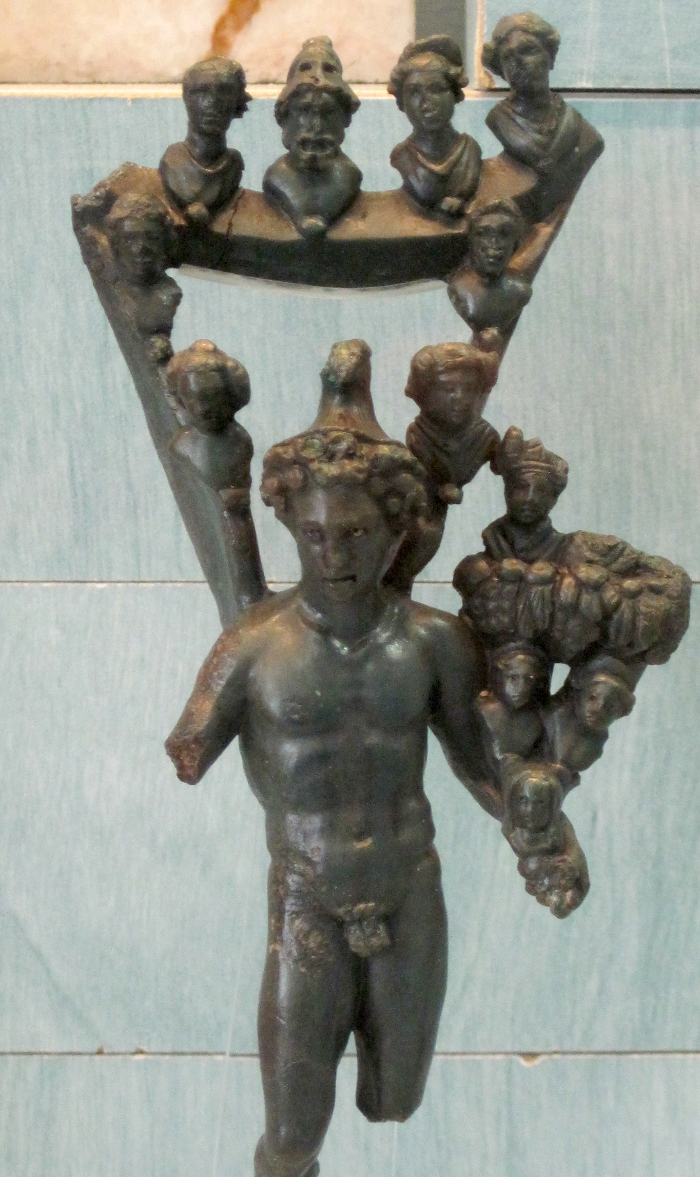THE GODS AND GODDESSES OF GAUL
A Gaulish pantheon?
 A fragmentary bronze statuette of Mercury Mercure Panthéus, i.e. Mercury surrounded by the eleven other Olympians as a few other deities as well (for a total of sixteen here). While the Gauls loved schemas like the twelve deities Olympus (just like the seven planets, the four seasons, etc.), their habits of worship were not rigorously subject to them.
(Musée Rolin, Autun)
A fragmentary bronze statuette of Mercury Mercure Panthéus, i.e. Mercury surrounded by the eleven other Olympians as a few other deities as well (for a total of sixteen here). While the Gauls loved schemas like the twelve deities Olympus (just like the seven planets, the four seasons, etc.), their habits of worship were not rigorously subject to them.
(Musée Rolin, Autun)
There simply was no single pantheon shared by all Celts of all ages. Those who have tried to ‘create’ one have too often mechanically applied the mythic literature of mediæval Ireland to classical or even pre-Roman Gaul—a wrong-headed method with unfortunate results.
Each Gaulish tribe had its own pantheon (a tribe or nation—later a Roman ciuitas—corresponds very loosely to a later French province or even a département). All the same, one can observe a host of shared regional characteristics and tendencies.
Here we shall present the national pantheon of the Treveri by way of example. This pantheon is comparatively well-known to us thanks to the great number of religious inscriptions found in Treveran territory. (The Treveri also straddle the modern-day boundaries of Belgium, Luxembourg, France and Germany, which heightens their inherent interest for citizens of all those countries today.) We shall simplify the picture in order to highlight the gods most widely attested in the inscriptions there.
The Treveri worshipped the following gods above all:
- Mercury
and Rosmerta, whose function was primarily economic
- Jupiter Optimus
Maximus and Juno the Queen,
political function
- Mars (especially
Lenus Mars) and Ancamna,
security function
- Apollo
and Ðirona, medical and artistic function
- Diana, animal function
- Minerva, artisanal function
- Silvanus, forests and fields
- Sucellus and
Nantosuelta, underworld function (?)
- Hercules, function of strength
- The Suleviæ, protectors of individuals
- Epona, equestrian function
- Vulcan, function of fire
Here we have the greatest gods and goddesses of central and northern Gaul. There are some interesting circumstances worthy of note. First, many deities seem to pair naturally, with a main deity and a paredros who completes or gives expression to the function of the first. (Those familiar with Hinduism may see a parallel here with Shiva-Shakti.) Without exception, the most important gods (Mercury, Jupiter, Mars, Apollo) have Latin names; however, their female paredri have Celtic names—with the sole exception of Juno and Minerva, partners with Jupiter in the Capitoline triad. This exception shows the importance in which the Treveri held the triad that guaranteed the stability of Rome, and thus of their own political and economic well-being. In all the other cases, however, the widely-noted phenomenon of Roman god conjoined with Celtic goddess demonstrates the interconnectedness of Roman and Celtic strata in Gaulish religion. Extricating the ‘purely’ Celtic from this rich synthesis seems a bit of a fool’s errand.
Lenus Mars gives us an example of another kind of Romano-Celtic synthesis: attributing to a Roman god a Celtic name and identity. The most frequent beneficiary of such identification is Mars. Unlike the Greek Ares, Mars was not conceived of as a bloodthirsty war-mongerer; rather, he plays an honourable part as defender of lands and fields—and even as a defender against disease. As guardian of the community’s security, Mars is apt to be identified with Celtic gods who would have played a similar role before the Roman conquest: Lenus Mars among the Treveri, Mars Mullo in Armorica (roughly today’s Brittany), and in other places Mars Toutatis, Mars Camulus, Mars Cicolluis, and so on.
Mars was not the only Celtic god to be endowed with a Celtic sobriquet.
Mercury, Apollo, Silvanus, and sometimes Jupiter and Minerva all received the same distinction. Among the Treveri, we have Mercury Cissonius and Mercury Visucius; Apollo Grannus; Silvanus Sinquas; and even “Vertumnus (Latin) a.k.a. Pisintus (native)”, linking together two fairly obscure gods.
Among the strictly classical gods, Vulcan, Diana and Hercules were all popular. The god of fire and patron of smiths—the protectress of forests and hunters—the paragon of strength and fortitude—all found a place of honour among the Gauls.
But it is the gods with Celtic names who have inspired the interest of most modern commentators, perhaps because less is known of their characters than of the Olympians’.
Sucellus, accompanied by the female paredros Nantosuelta in many depictions, has some chance of being the Celtic Dis Pater (god of the underworld) mentioned in our literary sources.
Epona is best known as patroness of horses and riders; she almost always appears on horseback or accompanied by horses. The Suleviæ act somewhat as genies or junos, looking out for the well-being of particular individuals; beyond this, they are not well known to scholars, and their humble cultus has left no identifiable depiction.
Other divinities, notably goddesses, belong to the ‘tribe’ itself. They are sometimes the guardians of important places (such as springs, mountains or rivers). We cite here as Treveran examples:
- Icovellauna, who presides over a spring
- Intarabus, a local god of the Ardennes (?)
- Ritona, patron of fords
- Boudina, warrior goddess (?)
The imperial cult was integrated into Gallo-Roman religion starting with the reign of Augustus and extending into the Crisis of the Third Century. This involved the worship of posthumously divinized emperors, the numen of the living emperor, and the honour of the “divine house”, which is to say the imperial family.
Genii, nymphs and lares were part of Gaulish religious practice. It can be seen that their worship was more intense in military zones (which were thus more ‘Romanized’) and in large urban centres. Among the Romans, every regiment, every guild and every association had its own ‘genius’, or protecting spirit. Individuals might pray to a genius or a juno who safeguarded their personal well-being. Lares guaranteed that of a household. As for nymphs, they are to be found presiding over springs, mountains, trees, and so on.
Aside from inscriptions, religious sculpture can reveal much that we would love to know more about. There are for instance sculptures of the so-called
genii cucullati, the import of which is much disputed. Gaul has also yielded many columns topped by an equestrian Jupiter riding down a serpent-legged giant. The scene invoked is clearly a sort of Gigantomachy, but there is evidently more to the story.
To approach the diversity of Gaulish deities from a different angle, see the summary of the various gods’ areas of specialty.
The Mysteries of the East
Cities, and especially militarized regions, bear witness to the so-called Oriental mystery cults. Though varied, these cults have certain traits in common: they were limited to initiates in a hierarchical structure; they claimed ‘exotic’ origins (variously Persian, Phrygian, Egyptian or Syrian); and they promised advantages in the afterlife through secrets and mysteries revealed to their devotees. Here is a summary of the gods of the Orient who experienced at least a period of vogue in Gaul:
A striking document
The list above enumerates the most important deities of the centre, north and east of Gaul. I put it together after fairly long analyses of the votive inscriptions of Gallia Belgica and Gallia Lugdunensis; if the Gauls had ever made a list of that kind, their list should bear some resemblance to ours. And what if they did? As it happens, another inscription—this time in Rome, put up by an élite cavalry corps—is in close accord with it. The corps was called the equites singulares Augusti (the Emperor’s Own Horse Guards), and at the time of inscription in question (CIL VI: 31141) they were recruited mainly in the parts of Gaul close to the Rhine (but also in the Danubian provinces). Done at Rome, the inscription is more Latinized than those of Gaul itself; but the choice of gods makes the most sense if it is seen from a Gallo-Roman lens. Around forty veterans contributed to the monument’s construction; they evidently sought to inventory all the most important gods for them (and who were fit to be publicly named). In any case, the following deities were invoked:
First to be invoked was the Capitoline Triad—guarantors of the empire’s integrity—followed by Mars and Victoria, so dear to the hearts of military men. The conjunction of Mars and Victory is not too surprising—but let us recall the frequent appearance of a female Gaulish paredros by Mars’s side (she is called Ancamna among the Treveri, Nemetona and Litavis elsewhere). Next are Mercury and Felicity, in a place of honour unexpected at Rome, but logical for the Gauls, for whom Mercury held a very privileged rank. It is Felicity who is the most surprising here. Should such a minor Roman goddess really take precedence over the Olympians Apollo and Diana? All is explained, in my view, by the fact that singulares Augusti were in Rome, where a Celtic name could not be expected to be understood. They meant Rosmerta and interpreted her name as Felicity according to the functions typically ascribed to her. All is as it should be.
The next deity is Salus, and this really is difficult to explain. We would expect Salus to represent the paredros of Apollo, as an interpretation of Ðirona. Why separate them? Why place the goddess several places ahead of the god? Here is a mystery. The next two names are not typical of Gaul, though they would not surprise us in a military zone—I refer to the Fates and the Camp gods. These last were chiefly worshipped in the Danubian provinces, and perhaps reflect the mixed character of the singulares Augusti, which were not after all an exclusively Gaulish corps.
The following deities, however, were favourites in Gaul, as we have seen: Silvanus, Apollo and Diana. The next, Epona, even has a Celtic name. Epona is probably the only Celtic goddess to be regularly worshipped in Rome. Popularized by Gaulish cavalrymen (and merchants, perhaps?), her name would have already been familiar to those reading the inscription. The Mothers may have been less well known, but their name makes their function immediately comprehensible. In this entire long list, only the Suleviæ openly proclaim their Gaulish origins; the others only betray it more subtly.
It is worth noting, by the bye, that many gods are left out that an actual Roman would have been likely to find indispensable: Vesta, protector of the domestic hearth no less than that of Rome; Ceres, whose place has been usurped by Felicity; Fortuna, in competition here with the Fates; and perhaps Venus, Neptune or Bacchus. To all these gods (apart from Fortuna in the military zone), the Gauls accorded a relatively minor place.
Comparing this list of the singulares Augusti with our own above, we perceive a remarkable concordance. Ours, which is longer, also includes Sucellus, Hercules, Vulcan and local deities. That of the singulares Augusti includes only two (groups of) gods, the Fates and the Camp gods, who do not appear on ours.
The inscription just analyzed is not the only one of its kind. It does suffice, however, to show that the ‘pantheon’ presented above as an outline fairly representative of northern and central Gaulish religion, would have been recognizable as such to the Gauls themselves.

En français svp !

Auf deutsch, bitte!
DEO ·
MERCVRIO · CETERISQ · DIIS ·
DEABVSQ · IMMORTALIBVS · VIDVCVS ·
BRIGANTICI · F ·
POST · R · C ·
AN · MMDCCLXV ·
V · S · L · M



